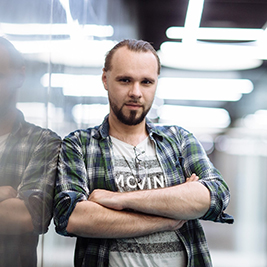Bank of Portraits / Hrinshtat (Khlipitko) Maria

Hrinshtat (Khlipitko) Maria
Polish woman Maria Khlipitko lived in the city of Novohrad-Volynskyi, Zhytomyr region. She lost her husband early, so she had to take care of her mother Antonina Dobzhanska, and little son Leonid. The beginning of the war put Maria`s family closer to death. She could hardly feed the family by what she earned on her job. Therefore, she spent her free hours walking across nearby villages, trying to exchange her belongings for some food.
She was wandering quite far from her home while looking for food. Once, after accomplishing more than 50 kilometers she reached the village of Mezhyrich Koretskyi, Volyn region (nowadays – Velyki Mezhyrichi, Rivne region). She met three Jewish sisters there: Sonia, Rita, and Zhenia. Despite the fact that the German occupation just had started (both Novograd-Volynskyi and Velyki Mezhyrichi were captured by Wehrmacht in early July of 1941) they all realized the danger, hovering over the Jews. That is why the woman assured sisters that they could account for her help in case of necessity.
Such a necessity upraised by the end of 1941 already. Mezhyrich Koretskyi was included to the Rivne gebiet – an administrative unit of the territories occupied by German troops. Rivne city itself, instead of Kyiv, supposed to be the capital of Reichskomissariat Ukraine. Therefore, much more attention was paid to the “Jewish problem” there.
By the beginning of the war in Mezhyrich Koretskyi lived about 3000 of Jews. Most of them lived off handcraft or owned small stores. In addition, since XVIII century Velyki Mezhyrichi was known as one of the centers of Hasidism. Moreover, Rabi Magid Dov Ber, the second leader of this religious doctrine, the apprentice of Baal Shem-Tov, who was its founder, was known as Magid of Mezhyrich.
The most tragic pages of the history of the Jewish community of Velyki Mezhyrichi village and Volyn region had started after the Nazi occupation. All the Jews of the village and countryside were registered. They had to carry yellow distinguishing badges shaped as David`s Star on their clothes. During the first weeks after the occupation Jews could live in their homes. However, they were subjected to pogroms, robbery, and humiliation. They also were forced to conduct physically difficult work, such as building, removal of debris, or cleaning the streets.
The first mass anti-Jewish action was conducted by Germans on May 22, 1942. About 1000 Jews were relocated by trucks to the sand quarry near the Devyn village and shot dead. Soon after that, the ghetto was created. About 800-900 Jews were detained there. They were exterminated in October of 1942 during the liquidation of the ghetto.
Sisters Sonia, Rita, and Zhenia remembered Maria`s promise of help. In October 1942, after the liquidation of the ghetto, they escaped to Novohrad-Volynskyi. Maria and her mother Antonina without hesitation harbored them in the attic. By that time, the women had been harboring one more escapee. It was a Red Army soldier, Avraam Hrinshtat who managed to escape from captivity.
Maria, her mother and son lived in poverty, risking to be revealed every moment. However, when two escapees from the Novohrad-Volynskyi ghetto, Jews Hekhman, and Isaak Kilikiivskyi asked to harbor them, she could not refuse.
Sometime after that, she connected with one of the underground groups’ leaders, which was acting in the region. With his assistance, she smuggled Avraam Hrinshtat, Isaak Kilikiivskyi, and Hekhman to the partisan’s unit.
Sisters Sonia, Rita and Zhenia were hiding at Maria`s house up to early January of 1944, when the Nazi occupants had been expulsed from the city by the Red Army.
Avraam Hrinshtat joined the Red Army. He was there up to the end of the war in Europe in 1945. In the summer of 1945, he returned to Novohrad-Volynskyi. Soon after that, Avraam and Maria got married. In 1996, they moved to Israel.
On May 27 1997, Yad Vashem awarded Maria Hrinshtat (Khlipitko) the title “Righteous Among the Nations”.

Maksym Milevskiy
Kyiv
National museum of the History of Ukraine in the Second World War
-
fingerprintArtefacts
-
theatersVideo
-
subjectLibrary
